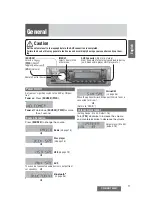
H0 Sound Decoder MX640 Page 13
CV
Designation
Range
Default
Description
#140
Distance
controlled
stopping
(constant stopping
distance)
Select start of
braking and
braking process
0 - 255
0
Activates distance controlled stopping as per
CV #141 in place of time-constant braking
according to CV #4.
= 1: automatic stops with “signal controlled
speed influence” or “asymmetrical DCC
signal”.
= 2: manual stops using the cab.
= 3: automatic and manual stops.
The start of braking is delayed in above cases
(= 1, 2, 3), if the train travels at less than full
speed to prevent an unnecessary long “creep-
ing” (recommended).
On the other hand:
= 11, 12, 13 selection as above but braking
starts always immediately after entering the
brake section.
#141
Distance
controlled
stopping
(constant stopping
distance)
Distance calculation
0 - 255
0
This CV defines the “constant stopping dis-
tance”. The right value for the existing stop
sections has to be determined by trial.
Use these figures as a starting point:
CV #141=255 is about 500m (or 6m in H0),
CV #141=50 about 100 m (or 1.2m in H0)
#142
Distance
controlled
stopping
(constant stopping
distance)
High-speed correc-
tion using the ABC
method
0 - 255
12
The delayed recognition (see CV #134) but
also unreliable electrical contact between rail
and wheels has a larger effect on a stop point
at higher speeds than at lower speeds. This ef-
fect is corrected with CV #142.
= 12: Default. This setting usually works fine if
CV #134 is set to default also.
#143
… compensation
using the HLU
method
0 - 255
0
Since the HLU method is more reliable than the
ABC method, no recognition delay is usually
required in CV #134; therefore this CV can also
remain at default setting 0.
#144
Programming and
update lock
Bits
6, 7
0
or
255
(255 =
„FF“,
which for
“old” de-
coders is
the same
as 0)
This CV was introduced to prevent uninten-
tional decoder changes or loss of functions due
to an inadvertent entry to the update mode.
= 0: Unrestricted CV programming and decoder
updates,
Bit 6 = 1: No programming possible in
service mode:
protection against uninten-
tional programming. Note: “on-the-main”
programming is still possible.
Bit 7 = 1: Software updates normally
executed with the MXDECUP, MX31ZL or
future devices are blocked.
(Unlock this CV with “on-the-main” pogram-
ming)
CV
Designation
Range
Default
Description
#145
Alternative motor
control method
0, 1,
10, 11, 12
0
= 0: normal control mode (DC & coreless
motors (Faulhaber, Maxxon)
= 1: special control for low-impedance DC mo-
tors (often Maxxon); this mode allows the
connection of a capacitor (10 or 22uF) to
the decoders positive and ground pads
which puts less stress on the decoder and
motor (but only if a capacitor is actually
present!) This method has not been tested
thoroughly.
= 10: “normal” C-Sinus and Softdrive-Sinus
control mode (same as CV #112,
Bit 0 = 1), FO4 is fixed and not available as
a function output.
= 11: alternative C-Sinus / Softdrive Sinus con-
trol mode, FO4 is available as normal
function output (not suitable for all C-
Sinus or Soft drive-Sinus equipped
locomotives).
= 12: special C-Sinus and Softdrive-Sinus
control mode for interfaces requiring the
normal motor output instead of the other-
wise more common C-Sinus output, FO4
is fixed and not available as function out-
put.
= 13: special C- / Softdrive - Sinus control for
“Märklin Gottardo” (and perhaps other
Märklin engines, instead of the otherwise
usual C-Sinus output), FO3 is fixed for di
rectional selection of front/rear 3
rd
rail
pick-up and therefore not useable other
wise.
#146
Compensation for
gear backlash during
direction changes
in order to
reduce start-up jolt.
MX640:
from SW-Version 4.1
0 - 255
0
A certain backlash between gears of a drive train is
required to prevent them from binding. This back-
lash may be more severe on some engines than
on others, especially when fitted with a worm gear.
An engine with a worn gearbox also exhibits ex-
cessive backlash.
Excessive backlash leads to a peculiar behavior
especially when changing the direction: When the
motor starts spinning in the opposite direction it
doesn’t move the engine because it has to elimi-
nate the backlash first. Also, soon after it starts
spinning it may enter the acceleration phase.
When the motor finally starts to move the engine,
the motor’s speed has exceeded the normal start-
up rpm, which results in an unpleasant jolt. This
can be avoided with the help of CV #146.
= 0: no effect
= 1 to 255: the motor spins at minimum rpm (ac-
cording to CV #2) for a specific time. Acceleration
starts after that time has elapsed. This comes only
in effect when a direction change has been per-
formed previously.














































